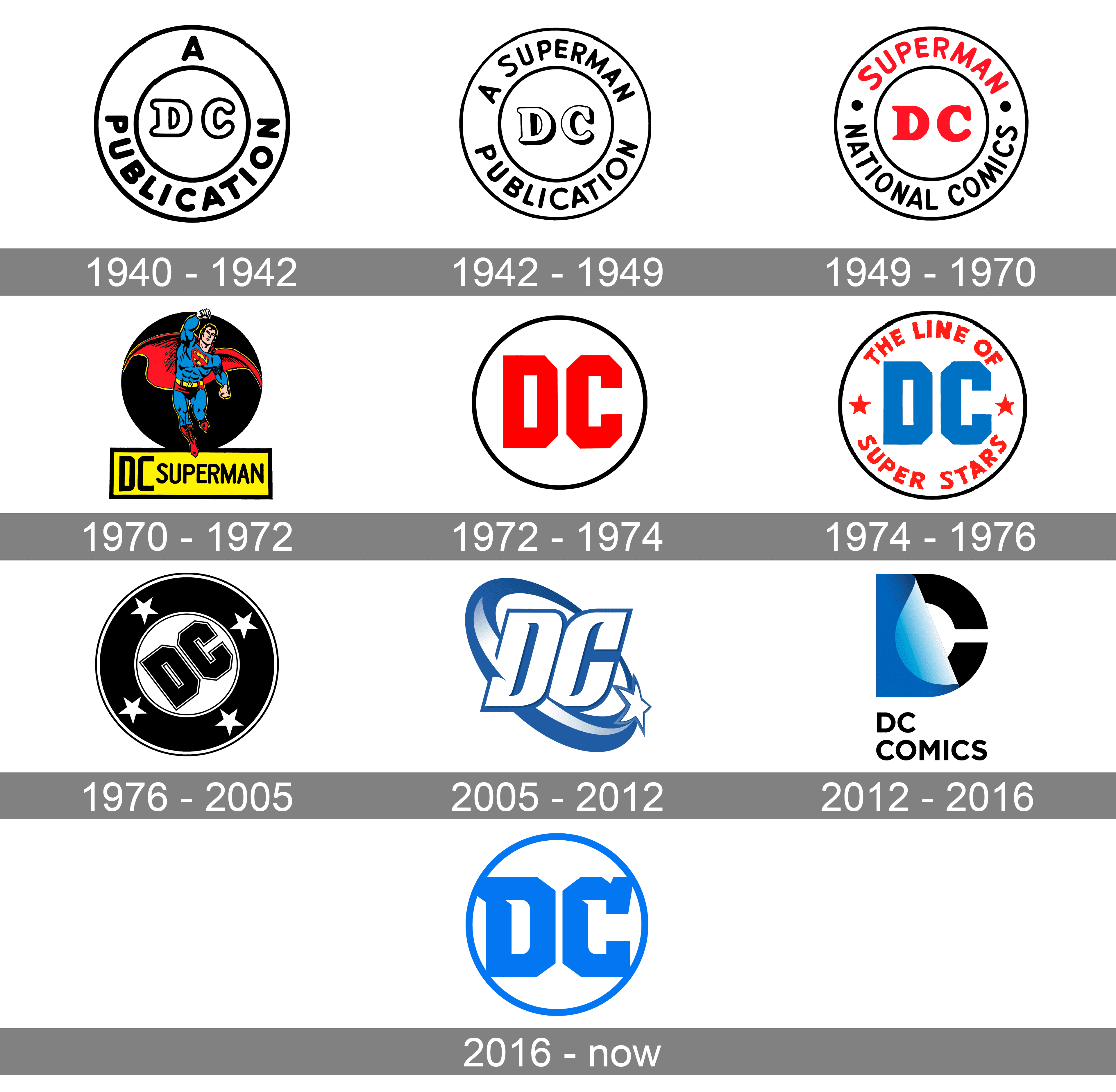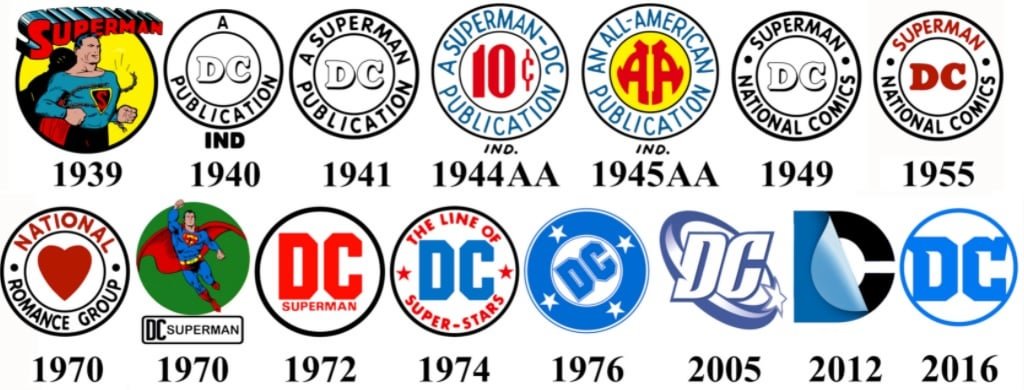The DC Comics logo has a rich history. It spans decades of comic book evolution.
DC Comics is a pillar of the comic book world. Their stories and characters are iconic. The logo, a symbol of these tales, has changed over time. Each version reflects the era’s style and design trends. From the early days to the modern era, the logo has evolved alongside the company.
Understanding the history of the DC Comics logo offers insight into the brand’s journey. It shows how design changes mirror shifts in the comic book industry. In this blog, we’ll explore the fascinating history of the DC Comics logo and its various transformations. Let’s dive into the world of superheroes and graphic design!

Early Beginnings
DC Comics has a rich history that dates back to the early 20th century. The company’s logo has evolved through the years. Each change reflects the brand’s growth. In this section, we explore the early beginnings of the DC Comics logo.
First Emblem
The first emblem appeared in 1940. It was simple. The design featured the letters “DC” inside a circle. The circle was solid black. The letters were white. This emblem was bold and clear. It made the brand easily recognizable.
Initial Design Elements
The initial design had key elements. The letters “DC” stood for “Detective Comics.” The circle shape represented unity. The contrast of black and white was striking. This made the logo stand out. The simplicity helped in print media. It was easy to reproduce.
The Golden Age
DC Comics’ logo history during ‘The Golden Age’ saw the iconic emblem first introduced in 1940. The logo featured simple, bold lettering, setting the stage for future designs. This era marked the beginning of DC’s rise in the comic book world.
The Golden Age of DC Comics began in the late 1930s. This era saw the birth of iconic superheroes. Superman, Batman, and Wonder Woman became household names. The logo played a crucial role during this time. It helped build a strong brand identity.Introduction Of The Shield
In 1940, DC introduced the shield logo. It featured the letters “DC” inside a shield shape. This design became symbolic. It gave the brand a heroic feel. The shield represented strength and protection. It aligned perfectly with their superhero themes.Impact On Brand Identity
The shield logo had a significant impact. It made the brand easily recognizable. Fans could spot it from afar. This recognition helped build loyalty. The logo was on every comic book cover. It connected readers to their favorite heroes. The shield became a symbol of quality storytelling. The consistent use of the shield logo was key. It cemented DC’s place in popular culture. Today, it remains an important part of the brand’s history. “`The Silver Age
The Silver Age of DC Comics was a time of great change. This period saw the birth of many iconic superheroes and a renewed interest in comic books. During this time, DC Comics made significant changes to its logo, reflecting the modern era.
Modernization Efforts
In the Silver Age, DC Comics aimed to modernize its logo. The goal was to make it look fresh and appealing. The logo featured a clean and simple design. The letters “DC” were prominently displayed. This change made it easily recognizable.
The new design was bold and clear. It represented the company’s forward-thinking approach. The modernization efforts were part of a larger strategy. DC Comics wanted to attract a younger audience. The new logo played a crucial role in achieving this goal.
Influence Of Contemporary Art
Contemporary art heavily influenced the new logo design. Artists of that time experimented with new styles and techniques. This influence was evident in the sleek lines and minimalistic design of the logo.
The logo’s design reflected the art movements of the 1950s and 1960s. Pop Art, with its bold colors and simple shapes, was a significant influence. The new logo embraced these elements. It was both modern and timeless.
DC Comics’ logo during the Silver Age became an icon. It represented the company’s innovative spirit. The influence of contemporary art helped the logo stand out. It was a perfect blend of tradition and modernity.

Bronze Age Changes
The Bronze Age of DC Comics brought significant changes to its logo. This period saw a shift in design, aiming to modernize and appeal to a broader audience. The logo underwent several transformations, reflecting the evolving identity of DC Comics.
Introduction Of The Circle
During the Bronze Age, DC Comics introduced a circular element to its logo. This new shape gave the logo a fresh, modern look. The circle added a sense of completeness and unity. It helped the logo stand out more on comic book covers. This design choice was a departure from earlier, more angular logos. The circle became a defining feature of the DC Comics brand during this era.
Typography Shifts
Another notable change during the Bronze Age was the shift in typography. The font used in the DC Comics logo became bolder and more streamlined. This new typography aimed to be more readable and impactful. It reflected the dynamic stories and characters within the comics. The updated font also aligned with contemporary design trends. These typography shifts further solidified the brand’s modern identity.
The 1980s Transformation
The 1980s marked a significant era for DC Comics. This decade saw a major transformation in its logo. The company aimed to reflect the evolving comic book industry. This change was not just about aesthetics. It was about redefining the brand’s identity and appeal.
New Symbolism
The new logo was introduced in 1977 but became iconic in the 1980s. It featured a stylized “DC” in a circle. The letters were bold and powerful. The circle symbolized unity and continuity. These elements represented the strength of DC Comics’ legacy. The logo was simple but effective. It was modern, yet respectful of its roots.
Audience Reception
The audience had mixed reactions initially. Some fans missed the old logo. They felt it had a classic charm. Others loved the new design. They found it fresh and exciting. Over time, the logo grew on everyone. It became a symbol of innovation. It represented the dawn of a new era in comics.
The transformation was crucial. It helped DC stand out in a competitive market. The logo became a symbol of quality and creativity. Fans started to associate it with their favorite superheroes. Characters like Superman, Batman, and Wonder Woman became even more iconic.
The 2005 Redesign
The 2005 redesign of the DC Comics logo marked a significant change. This update embraced the digital era. It reflected the evolving nature of the comic industry. The new design was sleek, modern, and versatile.
Digital Era Adaptations
The 2005 logo had to adapt to the digital age. The previous logo was static, designed for print. The new logo, however, needed to work across various digital platforms. This included websites, social media, and digital comics.
Designers focused on creating a logo that looked great on screens. It had to be clear and recognizable even at small sizes. The logo also needed to be adaptable for different media, from high-definition monitors to mobile phones.
Logo Versatility
Versatility was key in the 2005 redesign. The logo had to work in multiple contexts. This includes comic books, movies, and merchandise. It had to be flexible, easily tweaked for different uses.
The logo could change colors to match different themes. It could be animated for digital content. This flexibility ensured the logo stayed relevant and effective in diverse applications.
Here is a summary of the 2005 redesign’s key features:
| Feature | Description |
|---|---|
| Modern Look | Sleek and updated design |
| Digital Adaptation | Optimized for screens and digital media |
| Versatility | Adaptable for various uses and media |
The 2012 Refresh
In 2012, DC Comics decided it was time for a major refresh of their logo. This new design was a significant departure from previous versions. It aimed to reflect a modern, more sophisticated brand image. The 2012 refresh brought a sleek and minimalist approach to the DC Comics logo.
Sleeker Look
The 2012 logo introduced a sleeker look that was both bold and elegant. The new design featured a “peel” effect where the “D” appeared to peel back, revealing a hidden “C” underneath. This added a layer of depth and intrigue to the logo, making it visually appealing and memorable.
The choice of a simple, sans-serif font further enhanced this sleek appearance. The letters were clean and uncluttered, creating a modern feel that resonated with both new and longtime fans.
Minimalist Approach
The 2012 refresh embraced a minimalist approach that focused on simplicity and clarity. Unlike previous logos that were more detailed and colorful, this design relied on a monochromatic color scheme. This choice made the logo versatile and adaptable to various media formats.
- Single color scheme
- Simple geometric shapes
- Focus on clarity and readability
This minimalist design philosophy extended beyond the logo itself. It influenced the overall branding of DC Comics, from their comic book covers to their marketing materials. The result was a cohesive and streamlined brand identity that stood out in a crowded market.
| Feature | Details |
|---|---|
| Sleeker Look | Peel effect with hidden “C” |
| Font | Simple, sans-serif |
| Color Scheme | Monochromatic |
| Approach | Minimalist |

Current Logo Trends
DC Comics has a rich history of logos, each telling a unique story. Recently, the logo trends have shifted towards modern and sleek designs. They reflect the brand’s evolution while staying true to its roots. Let’s dive into the current trends of DC Comics logos.
Brand Consistency
Consistency is key in DC Comics’ current logo trends. The brand has managed to maintain a cohesive look across various media. This includes comic books, movies, and merchandise.
The current logo features a bold, simple design. It is easy to recognize and represents the brand effectively. The use of clean lines and minimalistic elements helps in achieving a timeless appeal.
Here are some elements of brand consistency:
- Uniform color palette
- Simple and bold typography
- Iconic “DC” letters
Future Predictions
The future of DC Comics’ logo trends looks promising. We can expect the brand to continue embracing modern design elements. This might include more dynamic and interactive logos.
Another prediction is the use of adaptive logos. These logos can change based on the platform or medium. For example, a logo might animate in a movie trailer but remain static on a comic book cover.
Key future trends might include:
- Interactive and animated logos
- Adaptive designs for different platforms
- Integration of digital elements
By staying ahead of design trends, DC Comics ensures its logo remains relevant. This helps in maintaining a strong brand identity in an ever-changing market.
Frequently Asked Questions
What Is The Origin Of The Dc Comics Logo?
The DC Comics logo first appeared in 1940. It has undergone several changes since then, reflecting the brand’s evolution.
How Many Times Has The Dc Logo Changed?
The DC Comics logo has changed 11 times. Each redesign reflects different eras and branding strategies of the company.
What Does The Dc Logo Represent?
The DC logo represents the iconic comic book brand. It symbolizes creativity, storytelling, and the legacy of superhero characters.
Who Designed The Current Dc Comics Logo?
The current DC Comics logo, introduced in 2016, was designed by Pentagram. It features a sleek, modern look.
Conclusion
The DC Comics logo has evolved significantly over the years. Each change reflects a new era in storytelling and design. Fans have witnessed the logo transition from classic to modern. These updates keep the brand fresh and exciting. The logo’s journey tells a story of creativity and innovation.
Its rich history continues to inspire comic enthusiasts worldwide. With each transformation, DC Comics remains a beloved icon. The logo’s evolution shows that change can be powerful. It captures the spirit of heroes and the adventures they bring.

